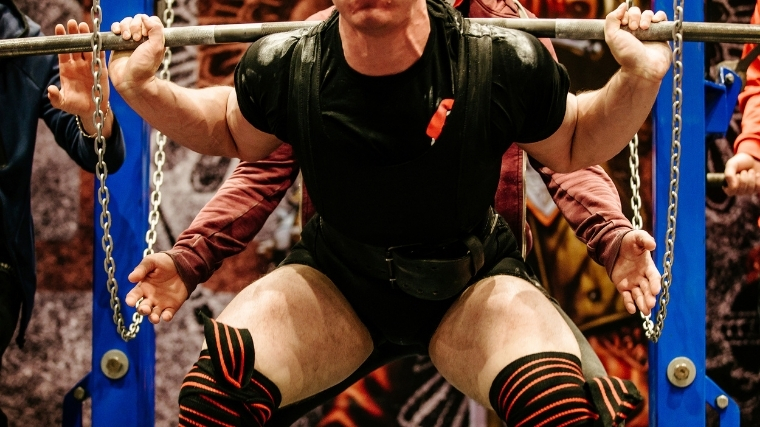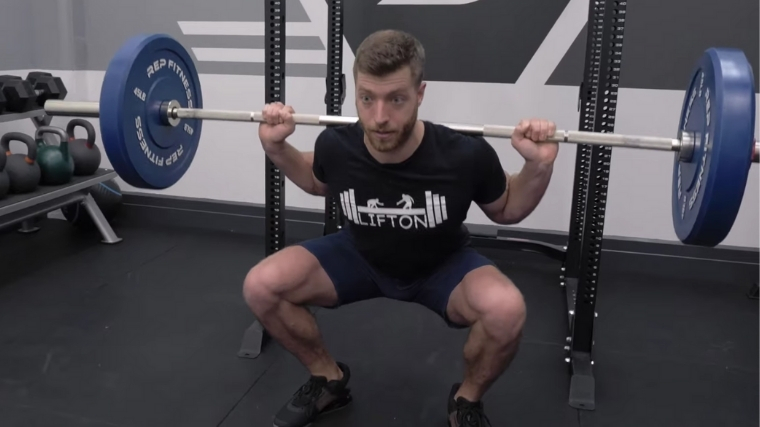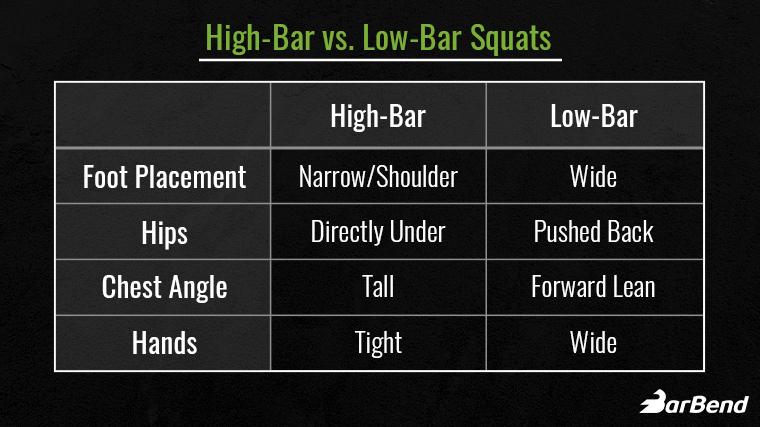When you’re getting yourself pumped up for a heavy squat session, you always want to head in with a game plan — you’ll want to know how you’re warming up, how many reps and sets you’re doing, and at what intensity. You also need to know what type of squat you’re planning to do, which involves a healthy understanding of the difference between high bar and low bar back squats.
If you’re a new lifter or a general gym-goer, you may not have heard of high-bar and low-bar squats before. They refer to where the bar sits on your back. Powerlifters typically use Low-bar squats since they allow you to stabilize yourself with more weight. High-bar squats elicit a more torso-up position. If you participate in any sport that’s not powerlifting or just squat for leg gains, chances are, ahem, high, that you’re already doing high-bar squats.
Curious to know more? Read up on the differences and then see which bar placement is a better fit for you and your goals.
The High-Bar Squat vs. Low Bar Back Squat — Form Differences
The primary difference between the low-bar and high-bar squat is bar placement on the back. To do the high-bar squat, you’ll lay the barbell on top of the shoulders, just below the C-7 vertebrae. A lot of times, you’ll hear people cue high-bar squat placement by saying, “Use your traps to create a shelf for the bar.”
[Related: Best Weightlifting Belts for Squats, Deadlifts, and More]
The low-bar squat places the bar further down on the back across the shoulder blades. A cue often used for low-bar squat placement is, “Lay the bar across the posterior deltoids (backs of shoulders).” In this case, you’ll also be creating a “shelf,” but much lower down. With the low-bar squat, you’ll think about more actively “pinning” the bar to your back rather than having it “sit” there.
How to Do the High Bar Back Squat
The high bar squat is the first version of a barbell squat that many — if not most — people learn when they start training. Many folks will step under the barbell, plop the bar onto their shoulders, and go, but it’s a little more complicated than that.
[Related: The Best Barbells for CrossFit, Weightlifting, Powerlifting, Deadlifts, and More]
- Make sure you’re centered as you step up to the bar, both in terms of bar position and your body. Plant your feet around shoulder-width apart, brace your core, and place your hands on the bar just outside your shoulders.
- Keep your shoulders away from your ears and engage your traps, settling the bar on the shelf created by the tension in your upper back.
- Stand to unrack the bar. Once the bar is settled, step back and re-establish your feet position.
- Press your knees out (instead of letting them cave in) as you descend into your squat, keeping your torso relatively upright so that the bar always remains in a vertical path above your midfoot.
- When you reach depth (just breaking parallel with your thighs), drive your feet into the ground and come back to standing.
- Re-brace your core and repeat.
How to Do the Low Bar Back Squat
Your setup will be relatively similar — and of course, you’re still squatting — but if you step under the bar properly for a low bar back squat, you’ll feel the difference pretty immediately.
[Related: Burn Fat and Boost Your Work Capacity With Body Conditioning]
- Make sure you’re centered as you step up to the bar, both in terms of bar position and your body — plant your feet a bit wider than shoulder-width apart and brace your core.
- Pull your elbows back behind you and engage your lats, so you’re creating a shelf with your rear delts — that will be where you pin the bar. Depending on your shoulder mobility, you might have to place your hands significantly wider than shoulder-width apart, but try to keep them as tight to your body as possible.
- Make sure the bar is pinned tightly to your back. It shouldn’t feel like it will slip once unracked. You should also notice that to keep your feet directly under the bar. You need to lean forward slightly.
- Stand to unrack the bar fully. Once it’s settled, step back and re-establish your feet position.
- Press your knees out (instead of letting them cave in) as you descend into your squat, making sure that the bar remains in a vertical path above your midfoot.
- When you reach depth (just breaking parallel with your thighs), drive your feet into the ground and come back to standing. It may be tempting to use your torso to power the bar up, especially if you shoot your hips up too fast. Don’t. Try to engage your hips and torso as one rigid unit as you rise, maintaining the same shape, angle, and bar path on the way up as you had on the way down.
- Re-brace your core and repeat.
Similarities and Differences Between the High-Bar and Low-Bar Back Squat
Regardless of whether you’re high-bar or low-bar squatting, the bar path should stay directly over the midfoot at all times. That’s why the low bar squat will produce a slight forward lean — because pinning the bar into your shoulder shelf will place the bar behind you, so you’ll lean forward very slightly to ensure that the bar is over the center of your feet. On the other hand, placing the bar on your traps with the high-bar squat sets the bar more or less automatically above the midfoot. Either way, though, your goal should always be to maintain that vertical bar path above your midfoot.
[Related: The Best Pre-Workout Supplements for Strength Cardio, And More]
Since you’re maintaining that bar path and movement pattern, you’ll also be working the same major muscles with both moves — be prepared to feel it in your glutes, hamstrings, and quads, regardless of whether you’re high-bar squatting or low-bar squatting. In a similar vein, squatting of any kind is going to be a full-body movement that will — especially when you’re lifting heavy — tax your central nervous system and put your core to work in a pretty big way.
The High-Bar vs. Low-Bar Back Squat — Performance Differences
General Strength
Both versions of the back squat will get you strong — but if you’re looking to really fine-tune your training, there are some differences to keep in mind. A study published in 2020 compared posterior chain muscle activation for high-bar and low-bar back squats. Researchers measured the bioelectrical activity in 12 very experienced male powerlifters. The study was the first of its kind to compare muscle activation between these squat types in the same group of lifters without moving the electrodes in between tests. (1)
During the squat’s eccentric portion, low-bar back squats were found to elicit much greater muscle activity in tested muscle groups than high bar back squats. The gluteus maximus and biceps femoris (hamstrings) were much more activated during the low bar squat than the high bar squat. The rectus femoris, vastus lateralis, and vastus medialis (quads) were also more activated during the eccentric portion of the low bar squat. Overall the differences between the two squat types for the quads were found to be negligible.
It’s important to note that the study only included young men who were either already competitive powerlifters or preparing for their first meet. Powerlifters tend to train low-bar back squats more than the high bar version, so the participants may well have been more experienced with low-bar than high-bar squats. Additionally, people of different genders, and varying training levels might experience muscle activation between the lifts differently.
It makes sense that the low-bar back squat is more effective for strength since you can typically load the bar with more weight. If you’re squatting solely to improve your one-rep max, the low-bar squat may be a variation worth trying.

[Related: The Best Whey Protein Powders for Vegans, Weight Loss, and More]
Muscular Hypertrophy
You certainly can work either type of squat in slightly higher-rep hypertrophy ranges — and you should, if your goal is muscle growth. But given that the 2020 study discussed above found that your glutes and hamstrings are more activated by the low bar back squat, it might be easy to assume that you should amp up the low bar reps if you’re looking to build some muscle.
That sounds logical, as long as you’re maintaining good form. Depending on your lifting background, ankle and hip mobility, and limb length, your form might be more likely to break down while you’re hammering out longer sets of low-bar back squats. If you’re the type of lifter who slips into good morning squat territory when low-bar squatting for more reps, you may be better off using high-bar squats for your muscle growth needs (until you iron out the kinks in your low bar squat).
Which is Better For Strengthening Your Main Lifts?
The type of squat you use on the regular depends on what your main lifts actually are. If you’re a powerlifter, one of your main lifts is the low bar back squat, so that’s what you’ll want to train with the vast majority of the time. But if you’re an Olympic weightlifter or CrossFitter — or generally love training with snatches, cleans, and jerks — the high bar back squat is going to strengthen your main lifts a lot more effectively.
That said, even if your main lifts call for one type of squat or the other to be used most of the time, that doesn’t mean you can’t benefit from switching it up some of the time. Methodically varying your training stimuli can help stop you from plateauing and iron out any weaknesses and notice any form of inefficiencies with the lift you’re typically using. So if you’re a weightlifter, don’t dismiss the low-bar squat completely — you might want to cycle it in when you’re building overall strength. And if you’re a powerlifter, cycle in the high bar when you’re looking to work hypertrophy into your training.
When to Use High-Bar Back Squats
High-bar squatting is great for multiple reasons. It’s essentially the most basic form of squatting and resembles the “athletic position/stance.” For example, if you asked someone on the street to drop into a squat, the chances are that their body position would mirror a high-bar style squat. The high-bar squat will have beneficial transfer into weightlifting and most sports.
William Quillman, C.S.C.S., USAW, is a Strength & Conditioning Coach based in Colorado Springs. When asked to weigh in on the differences between high and low bar squats, he says: “Weightlifting involves two movements: the snatch and clean & jerk. When squatting, one should try to be as specific as possible to have a high transfer over into the competition movements.
[Related: Get More Out Of Your Training With an Upper-Body Warm-Up]
The high-bar squat is commonly used in weightlifting, as this squat style allows an athlete to train in a similar torso, hip, knee, and ankle angles similar to competition movements.”
The athletic stance is a commonly used term to describe starting and movement positions for sports. This position involves the athlete standing with feet typically shoulder-width apart, hips under them, and knees slightly bent. A high-bar squat will help an athlete strengthen an athlete’s body in a way that closely mimics an athletic stance.
When to Use Low Bar Back Squats
The low-bar squat is typically utilized for two reasons: Moving more weight and increasing the load on the posterior chain. This squat style loads the posterior chain more by forcing the hips back to handle, absorb, and produce more force. This, in return, creates a forward lean of the chest and allows an athlete to lift heavier (upright torso can limit the body).
“Low-bar squats are used in powerlifting because it’s a way to express strength in the squat movement,” Quillman says. “The torso can be more horizontal while loads shift more into the posterior. This shift allows the glutes and hamstrings to become more involved and requires less range of motion than the high-bar squat. This makes this squat style easier to perform and typically allows the athlete to lift more.”
When the hips are forced back, the knees take less stress, which shortens the range of motion they go through (not as forward over toes). This shifts a lot of the weight’s stress into the hips, glutes, and hamstrings. The hamstrings will then pull back on the tibia (bone in the lower leg) and balance the force placed on the knee. For this reason, low-bar squats can be beneficial for athletes with knee issues.
How to Program Each Squat
You’ll program these lifts in relatively the same manner, with your set and rep scheme and intensity depending on your goals at any particular point in your program. Regardless of whether your current emphasis is on strength or hypertrophy since both squat types are big compound lifts that require a great energy investment, you’ll want to program them first in your day (i.e., squat before weighted lunges).
[Related: Check Out BarBend’s Squat Calculator]
Suppose you’re wondering how to integrate both variations into your program. That also depends on where you are in your training. If you’re within the final stages of prep for a powerlifting meet, for example, you’ll want to focus on low-bar squats (assuming that’s how you perform the movement in a meet). However, if you’re in the offseason, you might choose to switch things up and practice your high-bar squat a little more often to add that variety into your training.
For the most part, though, you’ll split your lifts based on your current training goals. For example, if you’re mostly looking to strengthen your Olympic lifts but still want to use both squat types, you might choose to program high bar squats 75 percent of the time. Since both squat variations require different mechanics to create force in the lower body, you’ll get used to producing force in multiple squat positions, which is beneficial both for competitions and for being a well-rounded athlete.
The Bottom Line
There may be no winner in the age-old battle between low-bar and high-bar back squats — only mutual appreciation. Both back squat types will get you strong, build muscle, and work your entire body. Sure, the powerlifters’ favorite — low-bar back squats — may elicit even more muscle activation (especially in the glutes and hamstrings), but you’ll still reap massive benefits from both lifts. And if you’re an Olympic lifter, CrossFitter, or just generally newer to lifting, the high-bar squat may well be more transferable to your current experience and goals. Whichever you choose (both are good), squat to depth and keep that vertical bar path pristine.
More Leg Training Tips
If you’re ready to get your squat on, make sure you’re thinking about lower-body training three-dimensionally. Check out these leg training articles to keep your program holistic.
- 10 Best Lower Body Exercises to Level Up Your Leg Day
- A Weightlifter’s Guide to Lower Body Hypertrophy Training
- Different Lower Body Training Volumes and Their Effects On Strength and Hypertrophy
- 3 Unusual Unilateral Leg Exercises to Improve Your Squat and Deadlift
References
- Murawa M, Fryzowicz A, Kabacinski J, et al. Muscle activation varies between high-bar and low-bar back squat. PeerJ. 2020;8:e9256. Published 2020 Jun 8. doi:10.7717/peerj.9256


